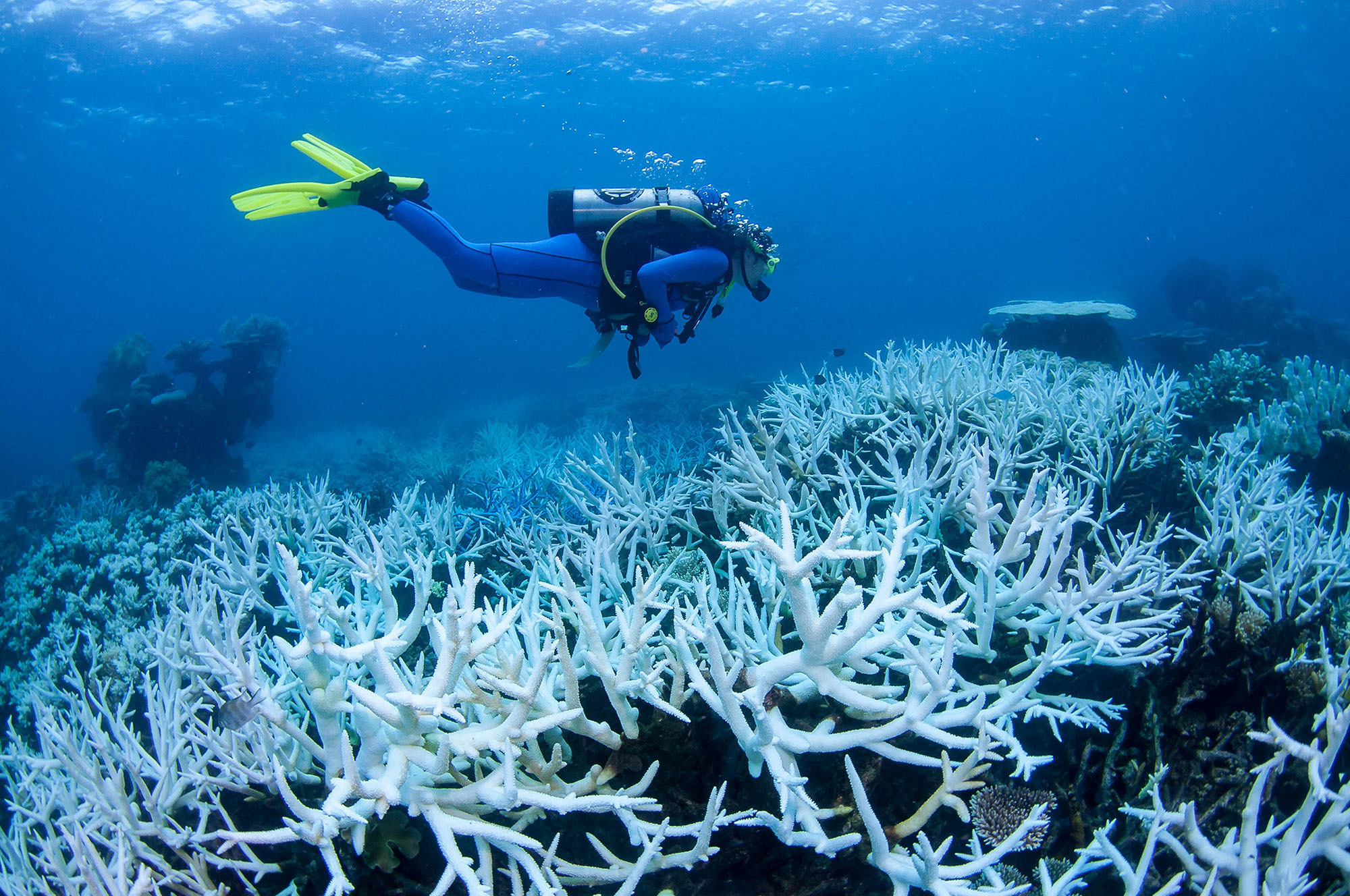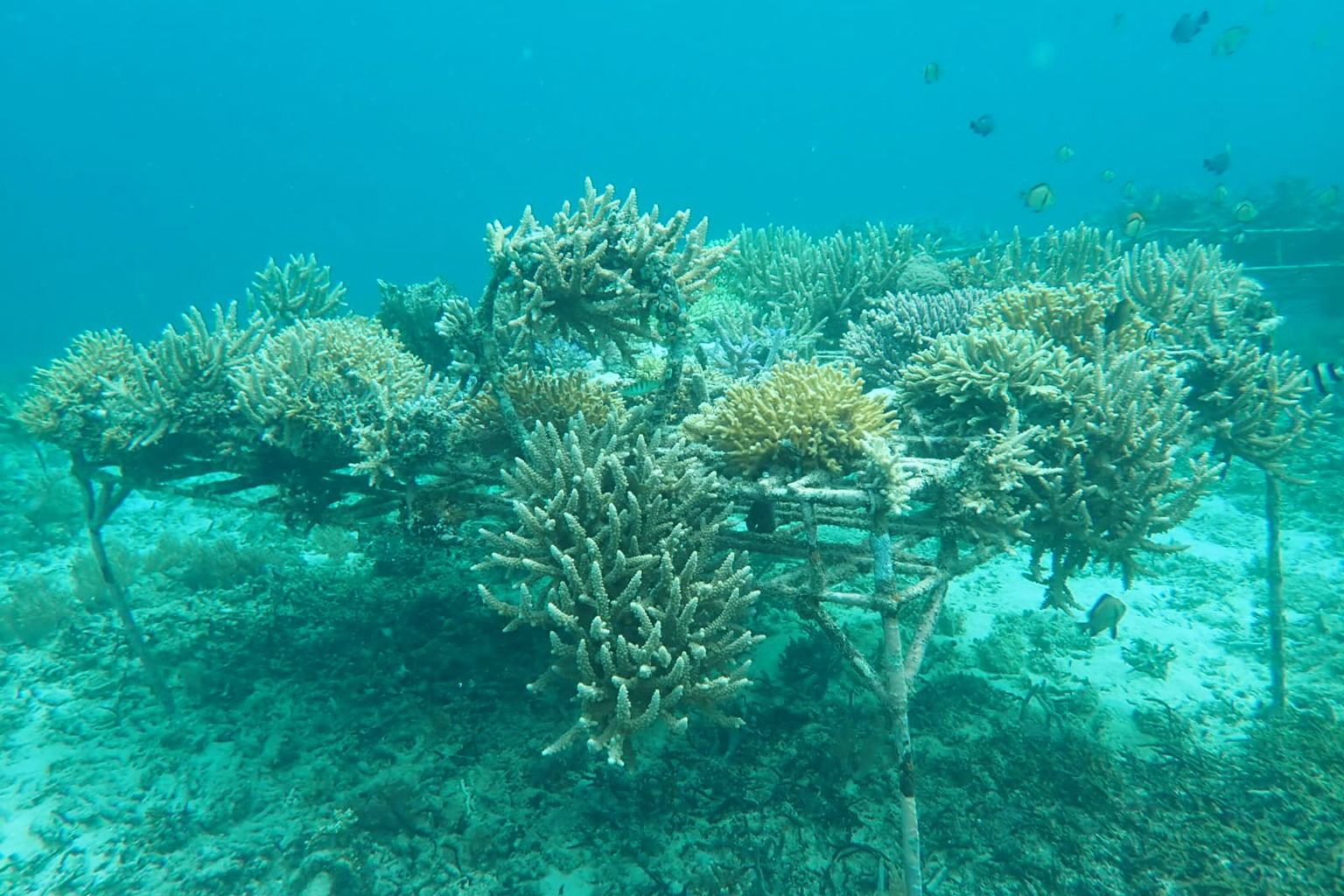Hundreds of millions of people in tropical regions – including in developing countries – rely on the natural resources produced by coral reefs. These stunningly biodiverse and vital marine ecosystems are home to about 4,000 species of fish, provide food to some 500,000 people, and secure revenues of trillions of dollars annually. They also protect the coastline from storm and wave damage thus helping over 5 million people to avoid property damage.
However, the tiny animals that build the reef structure are coming under increasing threats from local pressures such as pollution, overfishing, and destructive fishing techniques as well as the overwhelming global threat of climate change. Although billions have been invested in their restoration, experts have warned that this is just a drop in the ocean unless the effects of global warming can be reduced.
Climate change and the loss of keystone ecosystem engineers
Coral is the main architect of the reef. Coral polyps – tiny animals that usually grow in colonies – draw minerals from the seawater to create a calcium carbonate (CaCO3) skeleton. Their complex growth forms provide a variety of habitats for other reef organisms, without which the ecosystem quickly collapses.
Yet, the increase in carbon dioxide (CO2) emissions triggered by human activities has been jeopardizing this process. As CO2 dissolves in the ocean, it increases the water’s acidity, preventing corals from drawing calcium carbonate from the seawater to build their skeletons. This impedes the growth of the coral and its ability to reproduce.
An even bigger threat to coral reefs comes from increasingly frequent and severe mass bleaching events, largely caused by the increase in water temperature. For millions of years, corals have been sheltering algae which provide important nutrients and give the corals their colour. When water gets too warm, corals expel the algae from their tissues and turn completely white. While this bleaching is natural on reefs, scientists warn that it can lead to the widespread death of corals when higher water temperatures persist for too long.

Coral reefs around the world are experiencing increasingly frequent and serious mass bleaching events and widespread die-offs due to increased water temperatures continuing for extended periods of time. The fourth recorded global coral bleaching event began in December 2023, with the US-based National Oceanic and Atmospheric Administration recording mass bleaching on reefs throughout the tropics from the Florida Keys to the Pacific Islands. Scientists are predicting a return to normal temperatures by June, but this may already be too late for many reefs.
A move towards active coral reef restoration
If local stressors are not removed, passive conservation is not enough to manage reef health, and when combined with global climate change this means that not even protected reefs are safe.
This has led to a significant shift towards active coral reef restoration, including “coral gardening”, a technique that borrows approaches from silviculture, growing coral fragments in nurseries, and transplanting these into degraded reef areas to increase coral cover and restore ecosystem processes.
Substrate stabilisation is another increasing trend in many parts of the developing world. Coral larvae need a solid, stable surface on which to attach and start growing into a colony. In many scenarios, dead coral breaks down into coral rubble which shifts in ocean currents much like desert sand in the wind, essentially creating “killing fields” that exterminate newly formed coral recruits (larvae that have managed to attach themselves and start to grow).
Managing and measuring restoration success
Experts are calling for radical changes in the science, management, and governance of coral reefs so that restoration efforts provide social upliftment in local communities, as well as taking the potential future impacts of climate change into account.
There is a widespread belief amongst coral restoration practitioners that standardisation and broader ecological and socioeconomic tools to evaluate coral restoration success are crucial. If we do not measure the beneficial societal impacts of restoration, for example by quantifying food security, number of alternative jobs created, income generated for the community via tourism, sustainable fisheries, and other channels, etc., it will be much harder to judge success and we thus risk losing some of the main incentives for communities to preserve these ecosystems.
Impactful restoration initiatives
Funding for coral reef restoration has historically come mainly from government grants and private sector investments. However, countries are now creating legislative and regulatory structures for coral restoration and there are wide-ranging initiatives to unify efforts on a national, regional, and international scale.
Australia’s Reef Restoration and Adaptation Program (RRAP) is a national effort to protect, restore, and improve the resilience of the Great Barrier Reef (GBR). A concept feasibility study found that successful intervention could double the likelihood of sustaining the GBR in good condition by 2050, and RRAP launched its R&D program in late 2020, working on a range of methods to provide accumulating benefits.
Launched in 2021, the Global Fund for Coral Reefs (GFCR) works to enhance the resilience of coral reef countries and communities, with the aim of deploying US$625 million over 10 years to catalyse a sustainable financial ecosystem for coral reef conservation and development.

The Indonesia Coral Reef Garden (ICRG) was organised as part of a government-led economic recovery strategy for coastal communities in Bali that had been impacted by unemployment due to the COVID-19 pandemic. It is estimated to have employed 10,000 people in planting almost 96,000 artificial reef structures and coral nurseries across 74.3 hectares between October 2020 and January 2021.
Mars, Incorporated is a significant private sector driver for coral reef restoration. The company runs 40 restoration sites across 11 countries and last year led one of the largest single restoration events in history in Indonesia, bringing together 44 participants from 17 conservation and science partners across governments, NGOs, business sectors, and local communities to plant 30,000 corals across 2,500 m2.
Where to from here?
Progressive research is underway to try to incorporate more thermally resilient corals into restoration efforts. Corals that survive bleaching events are believed to be more resistant to future bleaching, while researchers are also investigating assisted evolution to aid coral restoration.
The 50 Reefs Initiative has identified those global areas with a higher potential to survive climate change impacts and serve as repositories of healthy, resilient corals to repopulate neighboring reefs over time. Researchers and restoration practitioners are also looking into ways of scaling up restoration efforts by addressing degradation at an ecosystem level. These include seeding the reef with small tetrapod-shaped concrete substrates settled with coral larvae and enhancing larval supply to areas with low natural coral recruitment.
For these and other efforts to be successful, however, social aspects cannot be ignored: once reefs are restored, local communities are the custodians of the reef. Cultivating a sense of ownership and ensuring community integration in restoration efforts are key to the survival of both coral reefs and those who rely directly on their natural resources.

